Much of the conversation about closing racial equity gaps in higher education focuses on how historically underrepresented students of color face much lower odds of making it to graduation, especially when it comes to a bachelor’s degree. Indeed, the six-year graduation rate for white students is 25 percentage points higher than that of Black students.
Less recognized is that underrepresented students who do make it to graduation still experience inequities both during college and after receiving their degree. New federal data on bachelor’s degree recipients highlight disparities that Black and Latinx students face in terms of how long it takes to graduate, the debt levels they are left with, and their employment prospects.
This column examines three important aspects of students’ experiences when attempting to earn a bachelor’s degree and pursue a career, drawing on new data from the National Center for Education Statistics. As part of a longitudinal study, nearly 20,000 graduates were surveyed about their experiences within 12 months of receiving their bachelor’s degree during the 2015-2016 academic year.
The data indicate that the higher education system is shortchanging Black students most dramatically. These students experience the longest time to completion, borrow significantly more than other students, and receive the lowest pay after graduation. Latinx students also experience a longer time to completion and are more likely to borrow. However, the gaps between Latinx and white students in debt levels and pay were not as severe as the gaps between Black and white students.
While Asian students have the best results overall, the data does not include a breakdown by subgroups that would likely identify populations who are more likely to experience educational inequality, such as those of Southeast Asian descent.
Ignoring these three points has allowed for an exacerbation of the racial wealth gap and prevents higher education from serving as an engine of mobility for people of color.
Graduates of color are experiencing longer paths to completion
Black and Latinx graduates experience significantly longer times to complete their bachelor’s degrees than white and Asian students. (see Table 1) Most alarming, Black graduates’ median time to completion of five years and four months is an entire year longer than that of white graduates. Latinx graduates faced a median time to completion of four years and eight months, just four months longer than white graduates.
In addition to average time to completion, the data show the percentage of students that take six or more years to graduate. Table 1 also shows that 40 percent of Black graduates took six or more years to graduate compared to 23 percent of white students, a 17 percentage point gap. Among Latinx graduates, 34 percent took six years or more to complete a degree. This means that Black and Latinx graduates will spend more time in school, less time earning wages, and potentially taking on higher debt.
The “Baccalaureate and Beyond Longitudinal Survey” does not address the reasons for these racial gaps. Factors that may contribute to the difference in completion time could include the fact that Black and Latinx students disproportionately attend institutions that have fewer resources to spend on teaching and supports. White students, however, are more likely to attend wealthier and more selective institutions.

Black graduates report higher levels of borrowing and higher debt burdens than any other group
Black graduates borrow and take on higher levels of debt more frequently than their peers. Black students are far more likely than any other group to borrow, at 86 percent, compared to an average of 67 percent of white students. Additionally, Black students are borrowing an average of $36,900 compared to an average of $30,500 for white students. Higher borrowing may be influenced by the longer times to completion. These findings confirm other data indicating that Black borrowers face a unique student loan crisis.
Interestingly, the data also show that while a slightly higher proportion of Latinx students borrowed than white students—70 percent compared to 67 percent—Latinx students borrowed less at an average of $26,900 compared to $30,500 for white students. This could reflect that Latinx students are much more likely to attend community colleges, which are less expensive. Finally, Asian students are the least likely to borrow, and these students have the lowest average debt.

Black and Latinx graduates see fewer returns in the labor market
This study also looks at data on employment, earnings, and access to employer benefits one year after graduation. The data show that graduates of color, including Asian graduates, face more challenges in joining the workforce. Sixty-nine percent of Asian graduates and three-quarters of Black and Latinx graduates reported being employed within a year of graduating compared to 83 percent of white graduates. (see Table 3) It should be noted that the percentage of employed students includes those who are working while enrolled in further education.
Another area of difference is that one year after receiving a bachelor’s degree, 70 percent of Black graduates are offered benefits through their employer compared to 76 percent of white and 75 percent of Latinx graduates. Furthermore, the median income for Black graduates is $36,000, compared to $40,000 for white graduates.

Conclusion
This study shows that race plays a pivotal role in time to completion; student loan borrowing and repayment; and employment outcomes for bachelor’s degree recipients. These disparities contribute to the racial wealth gap—leaving Black and Latinx graduates with less time in the workforce because their education takes longer and putting Black graduates in significantly more debt. Higher education leaders should scrutinize not just the gaps in who earns a degree but also the different experiences that graduates have in college depending on their race and their economic futures after college.
Ariana De La Fuente was a summer intern on the Postsecondary Education team at the Center for American Progress. Marissa Navarro is special assistant for Postsecondary Education at the Center.